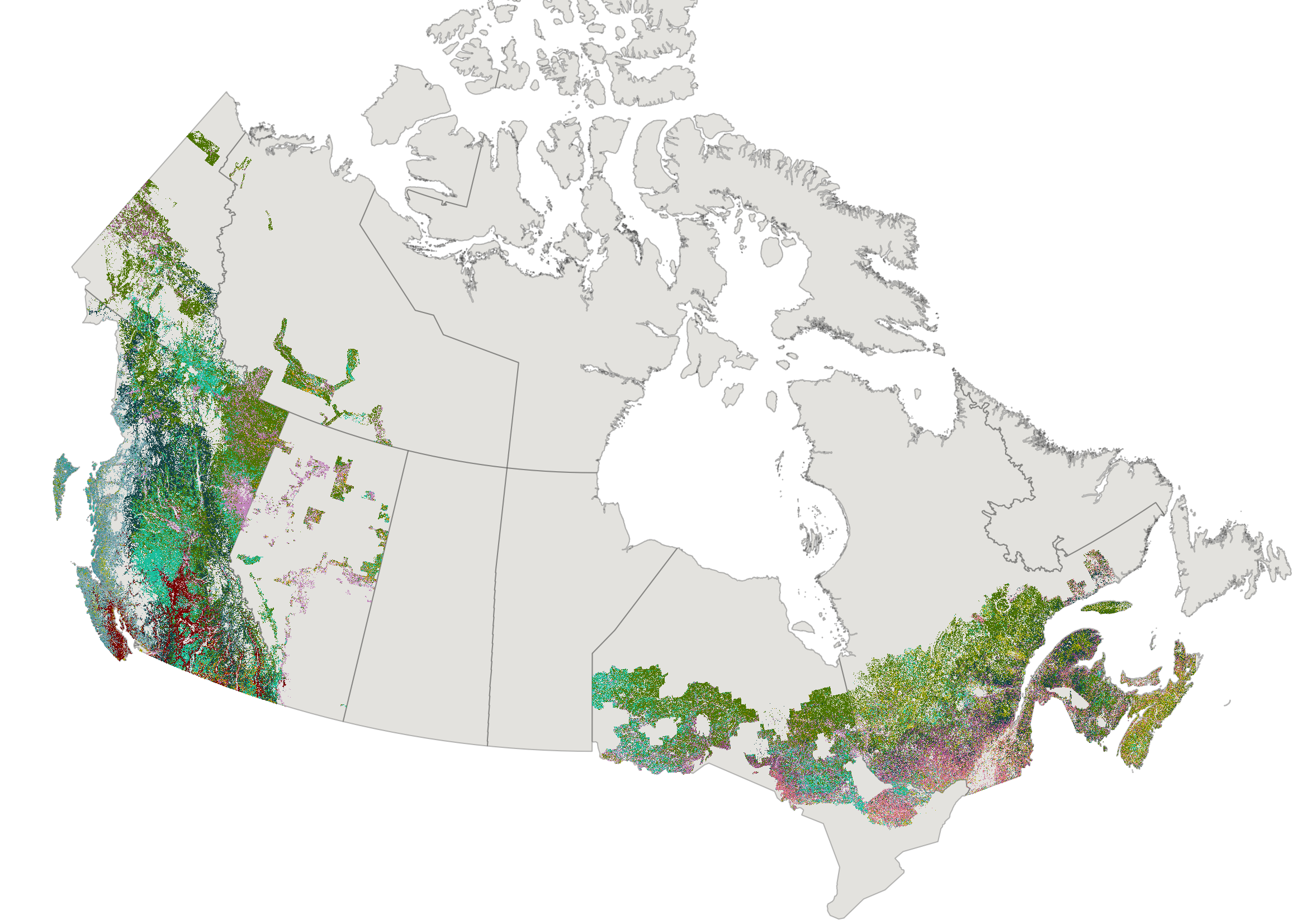Maps
Type of resources
Available actions
Topics
Keywords
Contact for the resource
Provided by
Years
Formats
Representation types
Update frequencies
status
Service types
Scale
-

The Canada Centre for Mapping and Earth Observation (CCMEO) has created a 30m resolution radar mosaic of Canada's landmass from the RADARSAT Constellation Mission (RCM). This product highlights different types of radar interaction with the surface, which can assist the interpretation and study of land cover on a national scale. The national mosaic is made up of 3222 RCM images acquired between August 2023 and February 2024. (Credit: RADARSAT Constellation Mission imagery © Government of Canada [2024]. RADARSAT is an official mark of the CSA.)
-
Canada Base Map Elevation (CBME) consists of a simple light hillshade for use as a background for mapping application. The Canada Atlas Lambert (EPSG:3978) is used and only covers the extents of Canada.
-

GeoSearch is an interactive mapping application that makes it easy to find places in Canada, see them on a map, and get basic geographic and demographic data for them.
-

Multi-Agency Ground Plot (MAGPlot) database (DB) is a pan-Canadian forest ground-plot data repository. The database synthesize forest ground plot data from various agencies, including the National Forest Inventory (NFI) and 12 Canadian jurisdictions: Alberta (AB), British Columbia (BC), Manitoba (MB), New Brunswick (NB), Newfoundland and Labrador (NL), Nova Scotia (NS), Northwest Territories (NT), Ontario (ON), Prince Edward Island (PE), Quebec (QC), Saskatchewan (SK), and Yukon Territory (YT), contributed in their original format. These datasets underwent data cleaning and quality assessment using the set of rules and standards set by the contributors and associated documentations, and were standardized, harmonized, and integrated into a single, centralized, and analysis-ready database. The primary objective of the MAGPlot project is to collate and harmonize forest ground plot data and to present the data in a findable, accessible, interoperable, and reusable (FAIR) format for pan-Canadian forest research. The current version includes both historical and contemporary forest ground plot data provided by data contributors. The standardized and harmonized dataset includes eight data tables (five site related and three tree measurement tables) in a relational database schema. Site-related tables contain information on geographical locations, treatments (e.g. stand tending, regeneration, and cutting), and disturbances caused by abiotic factors (e.g., weather, wildfires) or biotic factors (e.g., disease, insects, animals). Tree-related tables, on the other hand, focus on measured tree attributes, including biophysical and growth parameters (e.g., DBH, height, crown class), species, status, stem conditions (e.g., broken or dead tops), and health conditions. While most contributors provided large and small tree plot measurements, only NFI, AB, MB, and SK contributed datasets reported at regeneration plot level (e.g., stem count, regeneration species). Future versions are expected to include updated and/or new measurement records as well as additional tables and measured and compiled (e.g., tree volume and biomass) attributes. MAGPlot is hosted through Canada’s National Forest Information System (https://nfi.nfis.org/en/maps). ----------------------------------------------------------------------- SITES LEADING GENUS BY STEM COUNT LAYER: ----------------------------------------------------------------------- Shows the leading genus at each site for the most recently measured year, determined by counting the number of stems of each genus type. ----------- NOTES: ----------- The MAGPlot release (v1.0 and v1.1) does not include NL and SK datasets due to pending Data Sharing Agreements, ongoing data processing, or restrictions on third-party sharing. These datasets will be included in future releases. While certain jurisdictions permit open or public data sharing, given that requestor signs and adheres the Data Use agreement, there are some jurisdictions that require a jurisdiction-specific request form to be signed in addition to the Data Use Agreement form. For the MAGPlot Data Dictionary, other metadata, datasets available for open sharing (with approximate locations) and available data visualization products, please check all the folders in the “Data and Resources” section below. Coordinates in web services have been randomized within 5km of true location to preserve site integrity. Access the WMS (Web Map Service) layers from the “Data and Resources” section below. A data request must be submitted to access historical datasets, datasets restricted by data-use agreements, or exact plot coordinates using the link below. NFI Data Request Form: https://nfi.nfis.org/en/datarequestform --------------------------------- ACKNOWLEDGEMENT: --------------------------------- We acknowledge and recognize the following agencies that have contributed data to the MAGPlot database: Government of Alberta - Ministry of Agriculture, Forestry, and Rural Economic Development - Forest Stewardship and Trade Branch Government of British Columbia - Ministry of Forests - Forest Analysis and Inventory Branch Government of Manitoba - Ministry of Economic, Development, Investment, Trade, and Natural Resources - Forestry and Peatlands Branch Government of New Brunswick - Ministry of Natural Resources and Energy Development - Forestry Division, Forest Planning and Stewardship Branch Government of Newfoundland & Labrador - Department of Fisheries, Forestry and Agriculture - Forestry Branch Government of Nova Scotia - Ministry of Natural Resources and Renewables - Department of Natural Resources and Renewables Government of Northwest Territories - Department of Environment & Climate Change - Forest Management Division Government of Ontario - Ministry of Natural Resources and Forestry - Science and Research Branch, Forest Resources Inventory Unit Government of Prince Edward Island - Department of Environment, Energy, and Climate Action - Forests, Fish, and Wildlife Division Government of Quebec - Ministry of Natural Resources and Forests - Forestry Sector Government of Saskatchewan - Ministry of Environment - Forest Service Branch Government of Yukon - Ministry of Energy, Mines, and Resources - Forest Management Branch Government of Canada - Natural Resources Canada - Canadian Forest Service - National Forest Inventory Projects Office
-
This map is the base for a series of maps that depict Canada's involvement in a range of topics, including international trade and Canada's participation in various international partnerships and organizations. The dataset includes countries, major rivers, lakes and oceans, pacific island groupings, marine annotations, and country annotations, which are available for download in both English and French. Additionally, static maps of the world as well as each individual continent will be available for download in both English and French.
-

The Census Program Data Viewer (CPDV) is an advanced web-based data visualization tool that helps make statistical information more interpretable by presenting key indicators in a statistical dashboard. It also enables users to easily compare indicator values and identify relationships between indicators.
-

Multi-Agency Ground Plot (MAGPlot) database (DB) is a pan-Canadian forest ground-plot data repository. The database synthesize forest ground plot data from various agencies, including the National Forest Inventory (NFI) and 12 Canadian jurisdictions: Alberta (AB), British Columbia (BC), Manitoba (MB), New Brunswick (NB), Newfoundland and Labrador (NL), Nova Scotia (NS), Northwest Territories (NT), Ontario (ON), Prince Edward Island (PE), Quebec (QC), Saskatchewan (SK), and Yukon Territory (YT), contributed in their original format. These datasets underwent data cleaning and quality assessment using the set of rules and standards set by the contributors and associated documentations, and were standardized, harmonized, and integrated into a single, centralized, and analysis-ready database. The primary objective of the MAGPlot project is to collate and harmonize forest ground plot data and to present the data in a findable, accessible, interoperable, and reusable (FAIR) format for pan-Canadian forest research. The current version includes both historical and contemporary forest ground plot data provided by data contributors. The standardized and harmonized dataset includes eight data tables (five site related and three tree measurement tables) in a relational database schema. Site-related tables contain information on geographical locations, treatments (e.g. stand tending, regeneration, and cutting), and disturbances caused by abiotic factors (e.g., weather, wildfires) or biotic factors (e.g., disease, insects, animals). Tree-related tables, on the other hand, focus on measured tree attributes, including biophysical and growth parameters (e.g., DBH, height, crown class), species, status, stem conditions (e.g., broken or dead tops), and health conditions. While most contributors provided large and small tree plot measurements, only NFI, AB, MB, and SK contributed datasets reported at regeneration plot level (e.g., stem count, regeneration species). Future versions are expected to include updated and/or new measurement records as well as additional tables and measured and compiled (e.g., tree volume and biomass) attributes. MAGPlot is hosted through Canada’s National Forest Information System (https://nfi.nfis.org/en/maps). --------------------------------------------------- LATEST SITE TREATMENTS LAYER: --------------------------------------------------- Shows the most recently applied treatment class for each MAGPlot site. These treatment classes are broad categories, with more specific treatment details available in the full dataset. ----------- NOTES: ----------- The MAGPlot release (v1.0 and v1.1) does not include NL and SK datasets due to pending Data Sharing Agreements, ongoing data processing, or restrictions on third-party sharing. These datasets will be included in future releases. While certain jurisdictions permit open or public data sharing, given that requestor signs and adheres the Data Use agreement, there are some jurisdictions that require a jurisdiction-specific request form to be signed in addition to the Data Use Agreement form. For the MAGPlot Data Dictionary, other metadata, datasets available for open sharing (with approximate locations), data requests (for other datasets or exact coordinates), and available data visualization products, please check all the folders in the “Data and Resources” section below. Coordinates in web services have been randomized within 5km of true location to preserve site integrity Access the WMS (Web Map Service) layers from the “Data and Resources” section below. A data request must be submitted to access historical datasets, datasets restricted by data-use agreements, or exact plot coordinates using the link below. NFI Data Request Form: https://nfi.nfis.org/en/datarequestform --------------------------------- ACKNOWLEDGEMENT: --------------------------------- We acknowledge and recognize the following agencies that have contributed data to the MAGPlot database: Government of Alberta - Ministry of Agriculture, Forestry, and Rural Economic Development - Forest Stewardship and Trade Branch Government of British Columbia - Ministry of Forests - Forest Analysis and Inventory Branch Government of Manitoba - Ministry of Economic, Development, Investment, Trade, and Natural Resources - Forestry and Peatlands Branch Government of New Brunswick - Ministry of Natural Resources and Energy Development - Forestry Division, Forest Planning and Stewardship Branch Government of Newfoundland & Labrador - Department of Fisheries, Forestry and Agriculture - Forestry Branch Government of Nova Scotia - Ministry of Natural Resources and Renewables - Department of Natural Resources and Renewables Government of Northwest Territories - Department of Environment & Climate Change - Forest Management Division Government of Ontario - Ministry of Natural Resources and Forestry - Science and Research Branch, Forest Resources Inventory Unit Government of Prince Edward Island - Department of Environment, Energy, and Climate Action - Forests, Fish, and Wildlife Division Government of Quebec - Ministry of Natural Resources and Forests - Forestry Sector Government of Saskatchewan - Ministry of Environment - Forest Service Branch Government of Yukon - Ministry of Energy, Mines, and Resources - Forest Management Branch Government of Canada - Natural Resources Canada - Canadian Forest Service - National Forest Inventory Projects Office
-

The Common Attribute Schema for Forest Resource Inventories (CASFRI) is a Canadian forest resource inventory data repository. Forest resource inventory datasets in CASFRI are harmonized to a common data model so that data collected by different agencies following different standards can be used together. Participating provincial, territorial and federal government departments and agencies share current and historical map-based forest resource inventory datasets through CASFRI so that their data are available to users who’s areas of interest span multiple jurisdictions. CASFRI was originally developed by academic researchers (Cumming et al., https://doi.org/10.1139/cjfr-2014-0102). This flavour of CASFRI (CASFRIv5) was developed anew in collaboration with academic researchers at the University of Laval to provide a government version of CASFRI that is findable, accessible, interoperable, and reusable. It uses the most up-to-date forest inventory data provided by participating provincial, territorial, and federal government departments and agencies. CASFRIv5 is hosted on the Canadian Council of Forest Ministers’ data portal, the National Forest Information System (http://nfis.org).
-
RADARSAT-1, in operation from 1995 to 2013, is Canada's first earth observation satellite. Developed and operated by the Canadian Space Agency (CSA), it has provided essential information to government, scientists and commercial users. Ultimately, the RADARSAT-1 mission generated the largest synthetic-aperture radar (SAR) data archive in the world. In April 2019, 36,000 images were made accessible through the Earth Observation Data Management System (eodms-sgdot.nrcan-rncan.gc.ca). A heatmap of processed images was produced by the CSA and helps visualize the density of images available by mapped sector during the RADARSAT-1 mission.
-

Reference maps illustrate the location of census standard geographic areas for which census statistical data are tabulated and disseminated. The maps display the boundaries, names and unique identifiers of standard geographic areas, as well as physical features such as streets, railroads, coastlines, rivers and lakes. Reference maps include: Standard Geographical Classification (SGC) Census tracts Federal electoral districts
 Arctic SDI catalogue
Arctic SDI catalogue